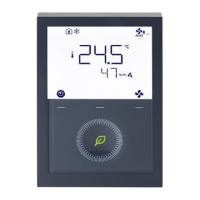1. When the thermostat is powered up, a close command for the actuator run time
by + 150 % is issued to ensure the actuator closes fully and synchronizes to
the control algorithm.
2. When the thermostat calculates the positions "fully close" or "fully open", the
actuator run time is extended by + 150 % to ensure the correct actuator
position is synchronized to the control algorithm.
3. After the actuator reaches the position calculated by the thermostat, a waiting
time of 30 seconds is applied to stabilize the outputs.
The demand calculated from the current room temperature and setpoint is supplied
via Y1, Y2 Y3, and Y4 to the valve actuator as a PWM (pulse width modulation)
signal for thermal actuators. The control output is activated for a period
proportional to the heating/cooling demand and then switched off for the rest of the
PWM interval.
The PWM algorithm cycle time is 1200 seconds (factory setting). It can be adjusted
via P206 (Y1), P207 (Y2), P208 (Y3) or P209 (Y4). These parameters are only
displayed if PWM is selected via DIP switches 7 and 8 and if PWM is selected via
P201, P203, P204, P205.
Proposed setting range for optimization, especially for thermal valve actuators
(STA, STP): 900 seconds (15min) to 1800 seconds (30min).
● The proposed PWM cycle (900…1800 seconds) allows to control thermal valve
actuators in parallel when used for floor heating/radiator systems.
● If several fan coil systems are controlled by the same room thermostat, it is
impossible with the PWM control signal to ensure exact parallel running of 2 or
more thermal valve actuators. We recommend setting On/Off (2-position)
control signals or using motorized actuators with On/Off or 3 position control
signal.
● For P-band (P050, P052, P054), see Control sequences [➙ 77].
To control electrical equipment, we recommend using a suitable external switching
element to switch the maximum current.
If output Y2 controls external mechanical relays, the optimal run time (P207)
depends on the technical characteristics of the equipment.
As initial setting, we suggest the following values, which can be modified within the
described setting range as needed:
To avoid burn-off of mechanical contacts by frequent switching, use a current valve
in place of a relay or contactor.
To avoid possible supply problems, when many consumers are switching on at the
same time in a building, consider the following:
● Set slightly different PWM cycles
● Do not switch all rooms to Comfort at the same time
This function is available with RDG26..KN only.

